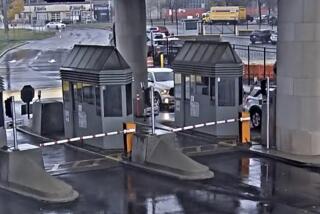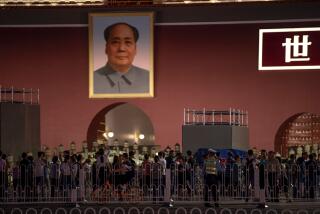China seeks suspects after car plows into Tiananmen Square

BEIJING — Chinese authorities were scouring Beijing for suspects from a region of northwestern China with a large Muslim population after a brazen attack at Tiananmen Square the day before that left five people dead.
In what could hardly have been a more audacious attack at the spiritual heart of China, a white sport-utility vehicle entered a sidewalk at the Beijing square midday Monday and drove nearly 500 yards, plowing through tourists and police, until it crashed near the iconic portrait of Mao Tse-tung that hangs over a main gate in the square.
The Chinese state news agency reported that five people were killed and 38 injured. The dead were the three occupants of the car and two tourists, a Philippine woman and a Chinese man.
Chinese authorities were looking for two suspects whose names identified them as Uighurs, according to a notice put out by police late Monday.
The Uighurs, an ethnic Muslim group from China’s Xinjiang region, have carried out a long and sometimes bitter campaign for greater autonomy. They have been implicated in numerous attacks against authorities in Xinjiang, but seldom in assaults in the center of Chinese communist power.
Authorities advised Beijing hotels to look out for two men from the towns of Pichan and Lukchun, which have been involved in deadly tit-for-tat violence with Chinese authorities. The notice said the men, ages 25 and 42, had at least one light-colored SUV and four different license plates. Police confirmed the authenticity of the notice, but referred further inquiries to the press office.
“There was a major criminal case in the city.... To prevent the suspects and vehicle from committing more crimes, now we require all hotels to report guests who have registered since Oct. 1 and the cars they have driven,” the authorities said in their notice.
Few other details were forthcoming from the official Chinese news outlets, and photographs were scrubbed clean from the Internet.
Nelson Bunyi, a Philippine pediatrician who suffered a fractured leg in the incident, said he had been on the sidewalk with his wife and two daughters when they spotted the vehicle heading toward them.
“A lot of people were running and jumping, but it was too late for me,” said Bunyi, who was lying in a hospital, oxygen tubes in his nose. “It was a white car and it was coming very, very fast. I fell to the ground. I remember there was smoke, not much else.”
The interview was interrupted when police, who were stationed in the hallway outside his room, said the patient could not be questioned without written permission.
On Tuesday morning, a family friend said that it was Bunyi’s wife, an obstetrician, who was the Filipina killed in the attack.
The New China News Agency said only that the cause of the incident was under investigation.
Tiananmen Square is blanketed at all times with paramilitary troops and police, in uniform and plainclothes, who mingle among the crowds. Cameras record every motion. Separating the street from the sidewalk are 5-foot-high white steel barricades designed to prevent the type of attack that took place Monday.
However, the white sport-utility vehicle appears to have entered at one of the few openings in the barricades, about 500 yards to the east of the square at the intersection of Nanchizi, a street running perpendicular to the main street, Changan. The driver then headed along the sidewalk toward the enormous Mao portrait, which hangs over the vermilion-walled “Gate of Heavenly Peace” (Tiananmen) that leads into the Forbidden City, erstwhile home of China’s emperors.
The vehicle appears to have burst into flames after crashing into a guardrail protecting Jinshui Bridge, a small stone pedestrian walkway in front of the gate. Photographs taken immediately after showed plumes of white and brown smoke rising from the scene. It is unclear whether the car carried explosives or whether it caught fire.
“The police were unprepared,” wrote one microblogger, who gave his name as Ma Min and who claimed to have information from witnesses.
Another, writing under the name Chen Renda, complained: “We have yet to hear the story behind the story. What was the real identity of the people inside the jeep?... Were there weapons found? Were there any pamphlets?”
Best known as the site of the 1989 crackdown on pro-democracy demonstrators, Tiananmen Square is a magnet for protesters and self-immolators. But most plots are foiled far from the square, such as a 2009 incident in which three people set themselves on fire in a car at the Wangfujing pedestrian mall, reportedly over personal grievances with the government.
Most of those injured Monday appeared to have been tourists or police. A nurse at Beijing’s Tongren Hospital said that in addition to the Philippine family, a Japanese tourist and a 5-year-old Chinese boy were among the injured.
The government appeared embarrassed by the apparent lapse in security in the heart of the city. There was no mention of the incident on the main 7 p.m. news Monday, which led with a report on the 11th meeting of the All China Women’s Federation. A report on the incident aired during the late news.
Beijing police closed off subway stations near the square after the crash and blocked vehicles and journalists.
Using high-pressure hoses, workers scrubbed the sidewalk clean and there was no trace of fire or explosion. But people knew what had happened from the sketchy reports and word of mouth and appeared to be surprised, and a little shaken.
Senior members of the Communist Party are to convene next month inside the Great Hall of the People, which is on the west side of the square, for a plenum to chart the nation’s economic future. Mao’s mausoleum lies to the south and Zhongnanhai, the compound of the top leadership, just behind the vermilion walls to the west.
Ilham Tohti, a prominent Uighur economist in Beijing, urged Chinese not to jump to conclusions about Uighur involvement in the incident.
“If there’s no evidence, they should not say it is Uighurs who did it, and they shouldn’t make the conclusion that Uighurs are involved in terror attacks,” Tohti wrote late Monday on Uighurbiz.net, a website he runs. “But we also can’t rule out the possibility that some Uighurs might have wanted to express their grievances through extreme measures.”
Xinjiang has frequently been the scene of violence, usually involving knives and homemade explosives. In July 2009, more than 150 people, mostly ethnic Han Chinese, were killed in street fighting in Urumqi, the worst ethnic violence in modern China in decades.
This year has been particularly deadly. In April, residents of Pichan alleged that a Han man had hacked to death a 7-year-old Uighur boy. In the aftermath, dozens were killed in Lukchun, which is part of the same county, in retaliatory attacks by Uighurs on Chinese police and authorities.
Chinese official sources referred to the incidents as “terror attacks” by “religious extremists.” Uighurs have said they were protecting themselves after Chinese authorities tried to arrest people for expressions of religion.
About 9 million Uighurs live in Xinjiang and face discrimination in employment, education and the practice of their religion, according to human rights advocates.
More to Read
Start your day right
Sign up for Essential California for news, features and recommendations from the L.A. Times and beyond in your inbox six days a week.
You may occasionally receive promotional content from the Los Angeles Times.






